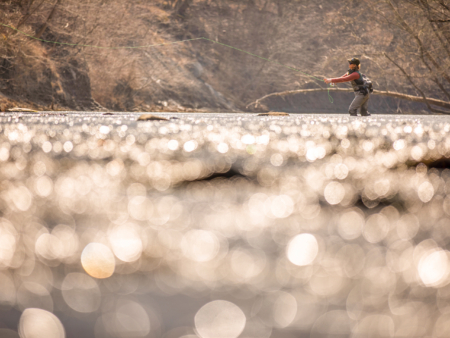It’s All Home Water: Cuyahoga Comeback
Ohio’s burning river made headlines in 1969. Now, the Cuyahoga’s telling a new story.
All photos by Andrew Burr
“Cleveland’s actually cool!”
It’s a refrain Clevelanders, like me, hear from countless out-of-staters who make the trip to visit and experience our attractions—particularly Cuyahoga Valley National Park (CVNP). Ohio’s only national park, the seventh-most-visited national park in the country, boasts a 33,000-acre mosaic of fog-draped valleys, forested trails and diverse wildlife, from soaring bald eagles to foxes and beavers, all within 30 minutes of downtown Cleveland.
The park’s crown jewel, the Cuyahoga River, weaves through dense oak forests on its journey north toward downtown Cleveland and Lake Erie. Anglers dot these tranquil waters, allured by the river’s more than 40 species of fish, from smallmouth bass to lake-run rainbows. They’re joined by a resurging population of blue heron and, often toward the river’s upper section, busy dam-building beavers.
It’s the kind of wild nature most don’t expect from northeast Ohio, and that’s understandable. In 1969, the heavily polluted Cuyahoga made national headlines when the river caught fire. Many wrote this river—and the city—off. Others stuck around to fight for it. Now, their work is paying off.
The Cuyahoga River is inching toward its removal from the Environmental Protection Agency’s (EPA) Areas of Concern list—a feat that could happen as soon as 2024—and it’s experiencing a recreation revival few could’ve imagined decades ago. The nearly 100-mile Cuyahoga River Water Trail was named USA Today’s best urban kayaking destination in 2021. And, for the first time since the creation of the EPA in 1970, the Ohio EPA deemed fish caught on the Cuyahoga as safe to eat.
Does the Cuyahoga rival fly-fishing meccas out west? Hardly. But it does have one hell of a comeback story—and there’s a new and growing community of anglers enjoying it that have typically been left out: women.
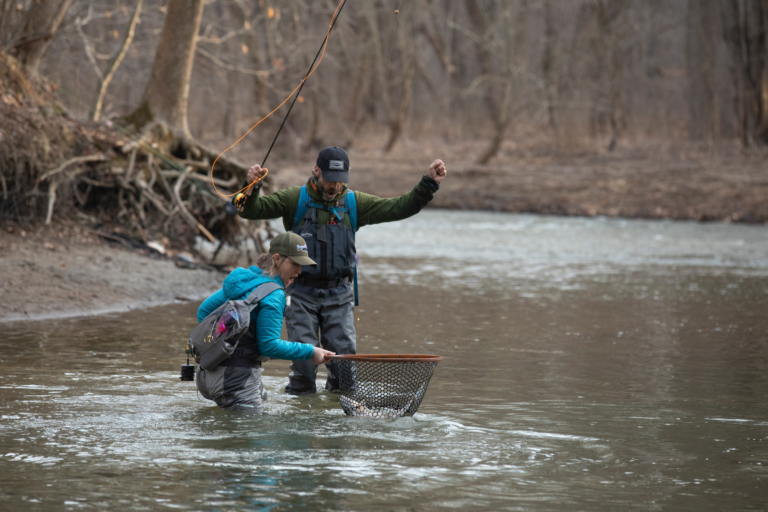
It’s a win-win situation. Karen Madachik scoops and Jeff Liskay scores on a Lake Erie tributary.
From Flourishing to Flawed
Like the rest of the world’s polluted waterways, the Cuyahoga wasn’t always rampant with waste and refuge. The U-shaped river, formed by glaciers after the last Ice Age, was once abundant with wildlife. It fed Indigenous communities, who inhabited the area as early as 13,000 years ago. One study of the Whittlesey people, who lived in the area from about 1,000 to 1,600 A.D., showed fish like white bass, catfish and yellow perch in their diet.
According to NASA’s Glenn Research Center, things changed for the Cuyahoga in the late 1600s, when the European fur trade marked the end of innocence for the river. Overhunted beavers were gone from the area by the 1830s. Indigenous communities were forced from their land around the same time.
Industry swept in with a vengeance. With its position along Lake Erie and connection to the country’s railway network, by the mid-1800s, Cleveland became a hotspot for manufacturing, particularly along the lower portion of the river near the city and lake. Iron furnaces, oil refineries, chemical factories and lumberyards dominated the Cuyahoga riverbanks.
With virtually no governmental regulations, these companies “were just using the river as their trash can,” says Ohioan Jordyn Stoll, a biological sciences doctoral candidate at Kent State University. The Cuyahoga became a flowing landfill, but the city took an out of sight, out of mind approach. That is until the river caught fire in June 1969.
There’s a reason water catching fire goes viral: Water shouldn’t catch fire. Water itself isn’t flammable but pollution that rises to the surface, like oil, very much is. Just look at the summer of 2021’s viral Gulf of Mexico blaze—the result of gas leaking from an underwater pipeline, then getting struck by lightning.
That ocean-on-fire image felt like doomsday. In the mid-1900s, though, it was par for the course. The Cuyahoga’s oily debris caught fire at least a dozen times before the world paid attention. But June 1969 was finally the right place, at the right time, for something to be done.
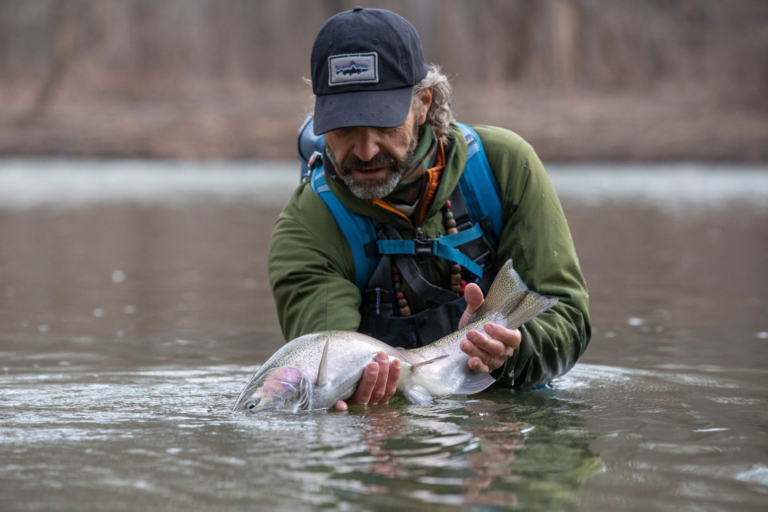
Northeast Ohio has more to offer than the newly resurgent Cuyahoga. Jeff Liskay returns a lake-run rainbow to the waters of a stream near the south shore of Lake Erie.
The Burning River
That June 1969 day started like any other: blue skies, factory-smoke plumes and a rancid smell of waste wafting from the oily, yellowish-black river. Then around noon, sparks from a passing train set pieces of floating, oil-drenched debris on fire for 30 minutes. The location? Just north of present-day CVNP. While it was five stories tall, the 1969 blaze had nothing on the five-alarm Cuyahoga River fire of 1952—but the news cycle in June 1969 made all the difference.
National reporters were already in Cleveland covering the election of Mayor Carl Stokes, the country’s first Black mayor of a major city. Several weeks later, news about the burning river shared space in Time Magazine with Ted Kennedy’s incident on Chappaquiddick and the Apollo 11 return from the moon. It was one of the magazine’s highest-circulating issues at the time, and Time did not mince words in its Cuyahoga story:
“Chocolate-brown, oily, bubbling with subsurface gases, it oozes rather than flows,” the magazine said of the river. “The lower Cuyahoga has no visible life, not even low forms such as leeches and sludge worms that usually thrive on wastes.”
This article turned Cleveland into the nation’s laughingstock—and yes, we still hear the “mistake on the lake” jokes to this day.
But while some turned to humor, others fought for change. “People were just fed up watching their environment be used as a trash can for industry,” Stoll says. “The burning of the river ignited this environmental movement.”
Frustration with environmental degradation also played into newly elected President Richard Nixon’s campaign promise to prioritize air and water pollution. In 1970, and largely due to this burning-river momentum, Congress approved Nixon’s Environmental Protection Agency legislation. And, in 1972, amendments to the Federal Water Pollution Control Act became today’s Clean Water Act.
With this legislation, the EPA could finally regulate pollution and set water-quality standards in places like the Cuyahoga. “They couldn’t just dump things in the river,” Stoll says.
Now, over 50 years since the big burn, a new Cuyahoga is coming. Sure, it remains on the EPA’s Areas of Concerns list—a list its own fires helped spark. And it’s hardly out of the woods yet. It briefly blazed again in August 2020 after a fire from a fuel tanker leaked into the river via storm drains. (The city’s sewage/drainage system is one of today’s most common pollution culprits.)
But local communities and organizations at the local, state and national levels are dedicating significant resources to get the Cuyahoga off this list, and dam removals are critical to the river’s long-sought victory.
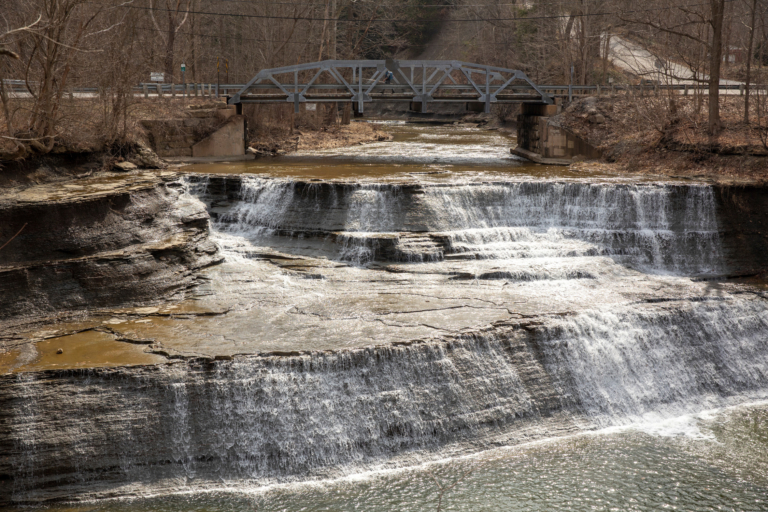
From Cleveland to Buffalo, NY, the creeks and rivers that flow into lake Erie are known as “steelhead alley.” And even if you’re not into chasing these mighty lake-run rainbows, the scenery can’t be beat. Paine Falls, northeast of Cleveland, is a 25-foot-tall cascade that spans 80 feet.
The Trouble with Dams
Dams were integral to 19th-century industry, but they worked hand in hand with manufacturing waste to obliterate the Cuyahoga’s health. “Dams change a river system to one that’s more like a lake,” Stoll says. This meant limited water flow on the Cuyahoga, with warmer water and fish that can’t pass upstream. “You lose diversity because habitat changes.”
The first significant domino to fall in the Cuyahoga’s dam-removal program was the Kent Dam, just outside Akron, built for mill power in the mid-1800s. This dam was an icon for the town of Kent; its cascading waterfall served as the backdrop for local weddings and family photos. To savor its history while preserving the environment, local officials agreed to a win-win solution completed in 2004: save a portion of the dam as part of a city water park while creating a bypass channel to let the river flow unobstructed.
The results were astonishing. By 2005, this stretch of the Cuyahoga met the EPA’s clean water standards within six months of removal. Fish like northern pike and smallmouth bass had returned to an area once dominated by catfish and carp.
The Kent success catalyzed subsequent dam-removal projects, with two of the most recent removals in 2020: the Pinery Feeder Dam and the Brecksville Dam. Removing these dams, both located in CVNP, was monumental for the fly-fishing community.
“You could catch fish above [these dams], but now within the last year, we’re catching fish above the area consistently. It’s unheard of,” says Jeff Liskay, a Cleveland angling veteran and guide who’s been fishing Ohio’s waterways for more than 35 years.
One last domino remains in the Cuyahoga dam-removal initiative, and it’s a big one: the Gorge Dam, a 60-foot colossal structure holding back 900,000 cubic yards of sediment. Its removal will cost around $70 million. Ohio anticipates the teardown could happen as soon as 2022. This could be the last straw to get the Cuyahoga off the EPA’s Area of Concerns list by 2024 or 2025, Stoll says.
But Ohioans don’t have to wait years to celebrate the river’s recent conservation achievements. In 2019, the Cuyahoga overcame one major EPA hurdle: It now has edible fish. For decades, the Cuyahoga’s fish were unsafe to consume due to pollution, but new fish-tissue sampling from 2018 showed major improvements.
From free-flowing water to new fish on the horizon, the Cuyahoga rushes with reclaimed vigor—and it couldn’t come at a better time. As the river system improves, Ohio’s female angling community is rapidly growing, bringing inclusivity to the state’s fly-fishing communities like never before.
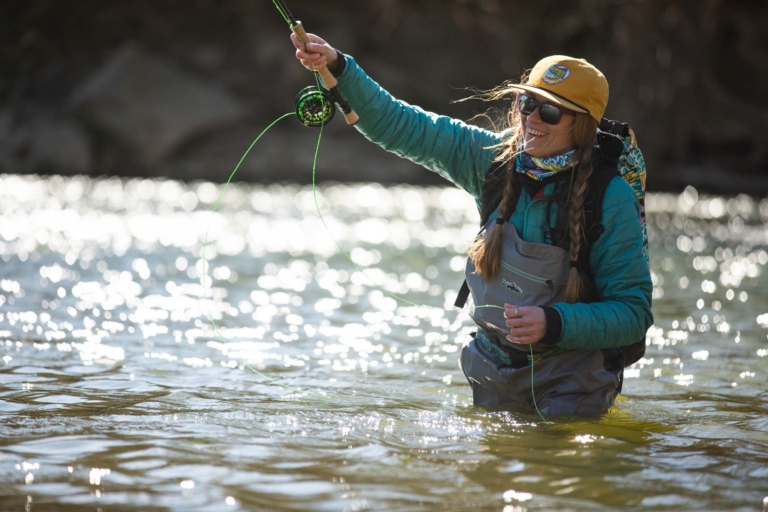
It’s way better for the fishing to be on fire than for the river to be on fire. Katie Johnstone lights it up on the Cuyahoga.
Ohio’s Female Fly-Fishing Boom
Female angler numbers throughout America have spiked in recent years. In 2018, female participation reached a high of 17.7 million anglers, with participants evenly dispersed across age groups, according to a 2019 report from the Outdoor Foundation and the Recreational Boating & Fishing Foundation. This trend is visible throughout Ohio, and the grassroots group Ohio Women on the Fly (OWOTF) is leading the charge.
The organization, dreamed up by founders Jessica Suvak-Tran of Cleveland and Katie Johnstone of Columbus, launched in 2019 with a makeshift Facebook page announcing a small fly-fishing outing in northeast Ohio. “That first meetup led to the community growing, which led to several more meetups and us hosting clinics,” Suvak-Tran says, noting she and Johnstone were begging speakers and partners to collaborate with them in the early days. “Now, every single day, we’re getting emails from men and women wanting to get involved with Ohio Women on the Fly.”
Suvak-Tran and Johnstone met Liskay early on during a group clinic for OWOTF members; he quickly moved from acquaintance to mentor to friend, sharing his hard-earned intel on Ohio’s fly-fishing scene. “This new group has just taken off,” Liskay says. In addition to OWOTF’s numbers, Liskay has noticed an uptick in female anglers joining his fly-fishing clinics with Cleveland Metroparks. “For the last two years, 50 percent of my attendees were females,” he says. “Across 30 years plus, I didn’t even meet half that many [female anglers].”
Liskay attributes the growth to more than just a nationwide trend. With OWOTF, it’s about inclusivity, a welcoming environment and not just educating women about how to fish—but also teaching men to foster and practice hospitality on the water. In the spirit of inclusivity, Suvak-Tran and Johnstone run seminars for Ohio’s male anglers, sharing how they can help women feel comfortable on the water.
“Jess and Katie—their hearts are in the right place,” Liskay says. “They’re thinking about protecting the water and how their actions can help it.”
This river conservation mindset is particularly important as Ohio’s fly-fishing community grows. With pandemic downtime, enhanced interest in outdoor pursuits and the revitalized Cuyahoga River, overcrowding has become an issue in Ohio’s angling hotspots. These days, even talking about a favorite fishing location sparks controversy and side eye.
Johnstone gets the angst. In addition to fly fishing, Johnstone rock climbs, and she used to climb in Kentucky’s Red River Gorge, known as the Red, “but that place is getting destroyed” due to overcrowding, she says. “I see this with fishing as well. It’s great to get all these people involved, but it’s a fine line because how many of these people are going to be stewards of this land?”
Liskay, who knows most nooks and crannies of the Cuyahoga, says his favorite once-hidden spots are no longer under wraps. It can be frustrating, he acknowledges, but he also recognizes this is public land and not his to claim. “You have to realize you’re not the only one here,” he says. “If you think you’re going to keep it to yourself, you’re crazy.”
Fortunately, these bubbling turf wars haven’t translated into backlash for OWOTF’s efforts to get more women on the water. And Johnstone and Suvak-Tran integrate eco-initiatives, such as river cleanups, restoration projects and water sampling, into their personal and community fly-fishing outings. They hope this work pays it forward, protecting the rivers they adore while fostering a community centered on love for the experience, not competition over the sport.
Plus, each dam removal unleashes a new wave of fishing options to disperse Ohio’s anglers even further. “When the Gorge Dam gets taken down, that’s so much river right there,” says Suvak-Tran, who grew up just outside CVNP and knows these waters well. “I’m hoping that this strong community of river supporters coming together and everyone helping each other out will lead to better river communication and sharing of the river.”
And Liskay, who’s watched the river transform from filthy to flourishing, sees nothing but positive momentum ahead for the angling community and the river as a whole. “The younger generation, they’re looking to protect [the river] and get involved, and I think it’s going to only get better—really better,” he says. “When you have a good group that everyone wants to get behind, it’s contagious. Everyone wants to be part of it.”
